|
|
|
|
|
Oil On
Canvas, Real Flavor of Old Masters
|
|

|
ARTWORKS
INDEX
A B C D E F G H I J K L M N O P Q R S T U V W X Y Z |
ARTISTS
INDEX
A B C D E F G H I J K L M N O P Q R S T U V W X Y Z |
|
|
| | |
|
|
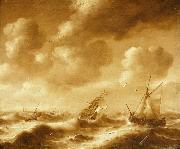 |
Hendrick van Anthonissen -- Click Here
|
|
(29 May 1605, Amsterdam - 12 November 1656, Amsterdam) was a Dutch marine painter.
Van Anthonissen was the son of Aert Anthonisz (a.k.a. Aart van Antum) and painted in the style of his brother-in-law and teacher Jan Porcellis and of Jan van Goyen. He is the author of sea paintings in the Hermitage, St. Petersburg and the Prague Gallery, which through their signatures have been ascribed to a mythical Hendrik van Antem. In the 1630's he lived in The Hague, Leiden, and Leiderdorp, but from 1642 he was back in Amsterdam. He is known for beach scenes and seascapes in the manner of Jan Porcellis, sometimes in grisaille. He was the father of the marine painter Arnoldus van Anthonissen.
|
|
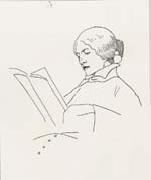 |
Heinrich Vogeler -- Click Here
|
|
1872-1942,German painter, printmaker and architect. He studied from 1890 to 1893 in D?sseldorf. In 1895 he bought the Barkenhoff in Worpswede, near Bremen. Soon afterwards, with colleagues from the WORPSWEDE COLONY, including Fritz Mackensen, Fritz Overbeck (1869-1909), Hans am Ende (1864-1918) and Otto Modersohn (1865-1943), he exhibited successfully at the Glaspalast in Munich. He provided illustrations for the periodical Die Insel, and undertook the interior decoration of the G?ldenkammer in Bremen. In 1906 he visited Ceylon (now Sri Lanka) for convalescence and in 1909 he went to England to study the principles of the garden city movement. He served in the German army in World War I, his writing of a pacifist letter to the Emperor in January 1918 prompting an official inquiry into his state of mental health. In 1919 he founded the Arbeitsgemeinschaft Barkenhoff in Worpswede, in an unsuccessful attempt to create an Arbeitsschule and a utopian community. |
|
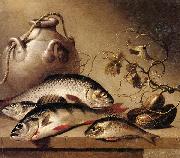 |
Harmen van Steenwyck -- Click Here
|
|
Dutch Painter of still lifes, notably of fruit ,
1612-1659 |
|
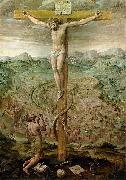 |
Hans Vredeman de Vries -- Click Here
|
|
(1527 - c. 1607) was a Dutch Renaissance architect, painter, and engineer. Vredeman de Vries is known for his publication in 1583 on garden design and his books with many examples on ornaments (1565) and perspective (1604).
Born in Leeuwarden and raised in Friesland, in 1546 Vredeman de Vries went to Amsterdam and Kampen. In 1549 he moved to Mechelen where the Superior Court was seating. Sebastian, his brother, was the organist in the local church. Vredeman de Vries designed ornaments for merry parades of Charles V and Philip II. Studying Vitruvius and Sebastiano Serlio, (translated by his teacher Pieter Coecke van Aelst), he became an internationally known specialist in perspective. He continued his career in Antwerp, where he was appointed city architect and fortification engineer. After 1585 he fled the city because of the Spanish occupation by Alessandro Farnese. Then the Protestants had to leave the city within two years. Vredeman de Vries moved to Frankfurt and worked in Wolfenbettel, designing a fortification and a new lay-out of the city for Julius, Duke of Brunswick-Leneburg. After his death the project was cancelled and Hans worked in Hamburg, Danzig (1592), Prague (1596) and Amsterdam (1600). On his trips Vredeman was accompanied by his son Paul and Hendrick Aerts.
Vredeman de Vries tried to get an appointment at the University of Leiden in 1604. It is not known when and where Hans Vredeman de Vries died, however, it is recorded that his son Paul was living in Hamburg when he inherited.
|
|
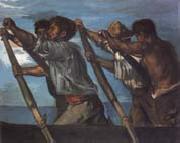 |
Hans von Maress -- Click Here
|
|
1837 Elberfeld-1887 Rome |
|
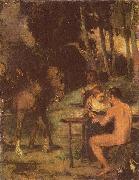 |
Hans von Marees -- Click Here
|
|
(24 December 1837 - 5 June 1887) was a German painter. He mainly painted country scenes in a realistic style.
Von Marees was born in Elberfeld, Germany. At age 16, he was sent to the Berlin Academy. In 1857, he moved to Munich.
In 1869, he visited France, the Netherlands and Spain. He served in the Franco-Prussian War (1870-71) and then lived in Berlin and Dresden for a while. In 1873, he decorated the library walls of the newly built Naples Zoological Institute in Italy. The next year, he moved to Florence.
He died in Rome at the age of 49 and is buried in the Protestant Cemetery there.
|
|
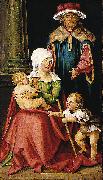 |
Hans von Kulmbach -- Click Here
|
|
(real name Hans Suess or Hans Seß) was born around 1480 in Kulmbach, Franconia and died previous to Dec. 3, 1522 in Nuremberg. Hans von Kulmbach was the artist who created the Krakew St. John's Altar.
Kulmbach probably arrived in Nuremberg around 1505. He received instruction by Jacopo de' Barbari, who for a time worked in Nuremberg. Von Kulmbach then apprenticed with Albrecht Derer and after Derer retired from painting altarpieces in 1510 Kulmbach took over most of his commissions. Kulmbach had his own workshop in Nuremberg and at times worked in Krakew. He also created artworks for emperor Maximilian I and for Margrave Casimir Hohenzollern von Brandenburg-Kulmbach. His best works were stained-glass windows in churches, such as the Maximilian stained-glass, Margrave stained-glass at St. Sebald in Nuremberg, the Welser stained-glass at the Frauenkirche and the Nikolaus altar at Lorenzkirche. In 1511 he finished the St. Mary's altar at Skałka in Krakew. The Catherine and St. John's altar also in Krakew, are among his best works.
|
|
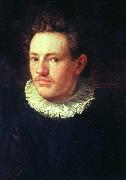 |
Hans von Aachen -- Click Here
|
|
was a German mannerist painter.
His name is derived from the birth place of his father, Aachen in Germany. Other variations of the name include Johann von - and - von Achen and various concisions like Janachen, Fanachen, Abak, Jean Dac, Aquano, van Aken etc.
Hans von Aachen began painting in Germany as a pupil of the Flemish master E. Jerrigh. He then moved to Italy in 1574 to study further. He toured Rome and Florence, but eventually settled in Venice. He initially became a pupil of Kaspar Rems, but soon decided to develop his own mannerist technique, by studying Tintoretto and Michelangelo's followers. However, during all of his life he was influenced by the style of Bartholomeus Spranger and Hendrick Goltzius who dominated the art scene in Germany at the time.
He returned to Germany in 1588 where he became well known as a painter of portraits for noble houses. He painted several works for Duke William V of Bavaria. He married Regina, the daughter of the composer Orlando di Lasso in Munich. In Munich he came into contact with the Imperial Court in Prague. In 1592 he was appointed official painter of Rudolph II, Holy Roman Emperor. However, Von Aachen only moved to Prague in 1601, where he stayed painting commissions from Emperor Rudolph II, and later from Matthias I.
Amongst van Aachens pupils were Peter Isaak and Joseph Heinz. His works have been copied by Wolfgang Kilian, Dominicus Custos and Jan Sadeler.
|
|
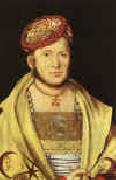 |
Hans Suss von Kulmbach -- Click Here
|
|
1476-1522
German
Hans Suss von Kulmbach Gallery
German painter and graphic artist. His real name was Hans S??ss. In general his work reveals the influence of D??rer, but he had little of the master's power. Von Kulmbach worked chiefly in Nuremberg, although he probably spent several years in Cracow as court painter. His masterpiece is the Tucher altarpiece for the Church of St. Sebald in Nuremberg. He also executed portraits and designs for painted glass.
|
|
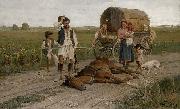 |
Gyorgy Vastagh -- Click Here
|
|
painted A karvallott cigany in 1886 |
|
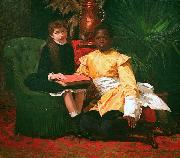 |
Gustaaf Vanaise -- Click Here
|
|
painted The Negroe and I in 1886 |
|
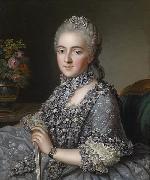 |
Guillaume Voiriot -- Click Here
|
|
Guillaume Voiriot (Paris, 1713 - Paris, 30 November 1799) was a French portrait painter. In the years of 1746-1749 Voiriot went, at its own expense, to Italy. After his return he became a member of the painters and sculptors guild at Academie de Saint-Luc. In the years 1759 to 1771 he regularly exhibited portraits of his contemporaries in the Paris Salon. He portrayed family members, scientists, writers, actors and musicians. |
|
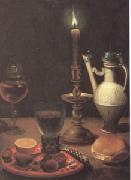 |
Gottfried Von Wedig -- Click Here
|
|
Cologne 1583-1641 |
|
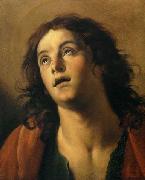 |
Giuseppe Vermiglio -- Click Here
|
|
Giuseppe Vermiglio (c.1585 - c.1635) was a Caravaggist painter from Northern Italy, active also in Rome.
Our knowledge of Vermiglioes life is sketchy. It is probable that he was born in Alessandria. He spent the first two decades of the seventeenth century in Rome where, while training and working as an artist, he adopted a bohemian lifestyle with a tendency to become involved in painterly brawling: in 1604 he supported his master Adriano di Monteleonees account of a dispute with two unknown artists which had led to Monteleone being wounded by his own wife; the following year Vermiglio was arrested and imprisoned after being discovered at the Monte di Brianza hostellry bearing an unlicensed sword; and in 1611 proceedings were brought against him for physically attacking the painter Silvio Oliviero. In 1618, still in Rome, he is recorded as a picture dealer.
Around 1620 he returned to northern Italy where he pursued his career as a painter in Piedmont (Novara and Alessandria) and in Lombardy (notably in Mantua and Milan).
His art was profoundly influenced by Caravaggio. Other painters to whom his work is thought, on the basis of stylistic references, to be indebted include the Bolognese Annibale Carracci and Guido Reni; it has been suggested that Vermiglio worked or studied in Bologna at some point. Luigi Lanzi acclaimed the painting of Daniel among the lions, in the library of the Passione in Milan, as his masterwork.
Judgments of quality of his work have ranged from Alfred Moires inconsequential craftsmane to Lanzies the best painter in oils of which the ancient state of Piedmont could boast, and one of the best Italian artists of his times. |
|
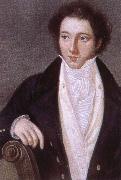 |
giuseppe verdi -- Click Here
|
|
Period: Romantic (1820-1869)
Country: Italy
Born: October 09, 1813 in Le Roncole, Italy
Died: January 27, 1901 in Milan, Italy
Genres: Chamber Music, Choral Music, Miscellaneous Music, Opera, Vocal Music
|
|
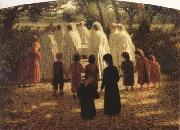 |
Giuseppe Pellizza da Volpedo -- Click Here
|
|
Italian, 1868-1907
was an Italian painter. He was born and died in Volpedo, in the Piedmont region of northern Italy. Pellizza, considered a neo-impressionist artist, was a divisionist painter - using small dots of paints according to specific color theory. His most famous work is Il Quarto Stato ("The Fourth estate"). This rich, expressive work has become a well-known symbol for progressive and socialist causes in Italy, and through out Europe. |
|
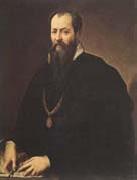 |
Giorgio Vasari -- Click Here
|
|
1511-74
Italian painter, architect, and writer. Though he was a prolific painter in the Mannerist style, he is more highly regarded as an architect (he designed the Uffizi Palace, now the Uffizi Gallery), but even his architecture is overshadowed by his writings. His Lives of the Most Eminent Architects, Painters, and Sculptors (1550) offers biographies of early to late Renaissance artists. His style is eminently readable and his material is well researched, though when facts were scarce he did not hesitate to fill in the gaps. In his view, Giotto had revived the art of true representation after its decline in the early Middle Ages, and succeeding artists had brought that art progressively closer to the perfection achieved by Michelangelo. |
|
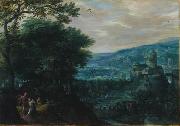 |
Gillis van Coninxloo -- Click Here
|
|
(1544 ?C 1607) was a Dutch painter of forest landscapes, the most famous member of a large family of artists. He travelled through France, and lived in Germany for several years to avoid religious persecution.
He was born at Antwerp and studied under Pieter Coecke van Aelst, Lenaert Kroes and Gillis Mostaert. He practiced his art in France, but in 1587, on account of religious persecution, emigrated to Frankenthal and passed his later life in Amsterdam, where he died in 1607.
Coninxloo ranks as one of the most important Dutch landscape painters of the transition from the sixteenth to the seventeenth century. He exercised a strong influence on Jan Brueghel the Elder, Schoubroeck, Savery, and other Flemish and Dutch landscape painters of the transition period. Coninxloo is considered the founder of a new approach to the painting of forests; while earlier forest landscapes had used woods as backdrops for human activity, van Coninxloo made them a subject, submerging tiny human figures in elaborate compositions of trees in hugely exaggerated scale.
During his stay at Frankenthal from 1588 to 1595, he influenced several better known Dutch landscape-painters collectively referred to as the Frankenthal School. Karel van Mander wrote about him and his father Jan den Hollander in his Schilder-boeck. He wrote that his teacher Pieter Coeke van Aelst was his cousin, and that his landscapes were among the best of all Dutch landscape artists.
|
|
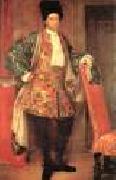 |
GHISLANDI, Vittore -- Click Here
|
|
Italian Baroque Era Painter, 1655-1743 |
|
 |
Gerrit van Honthorst -- Click Here
|
|
1590-1656
Dutch
Gerrit Van Honthorst Galleries
Gerard van Honthorst (November 4, 1592 - April 27, 1656), also known as Gerrit van Honthorst and Gherardo della Notte, was a Dutch painter of Utrecht. He was brought up at the school of Abraham Bloemaert, who exchanged the style of the Franckens for that of the pseudo-Italians at the beginning of the 16th century.
Margareta Maria de Roodere and Her Parents by Gerrit van Honthorst (1652) Oil on canvas, 140 x 170 cm. Centraal Museum, UtrechtInfected thus early with a mania which came to be very general in the Netherlands, Honthorst went to Italy in 1616, where he copied the naturalism and eccentricities of Michelangelo da Caravaggio. Home again about 1620, after acquiring a considerable practice in Rome, he set up a school at Utrecht which flourished exceedingly. Together with his colleague Hendrick ter Brugghen, he represented the so-called Dutch Caravaggisti. In 1623 he was president of his gild at Utrecht, where he had married his cousin. He soon became so fashionable that Sir Dudley Carleton, then English envoy at The Hague, recommended his works to the earl of Arundel and Lord Dorchester. In 1626 he received a visit from Rubens, whom he painted as the honest man sought for and found by Diogenes.
The queen of Bohemia, sister of Charles I of England and electress palatine, being in exile in the Netherlands, gave Honthorst her countenance and asked him to teach her children drawing; and Honthorst, thus approved and courted, became known to her brother Charles I, who invited him to England in 1628. There he painted several portraits, and a vast allegory, now at Hampton Court, of Charles and his queen as Diana and Apollo in the clouds receiving the duke of Buckingham as Mercury and guardian of the king of Bohemia's children. Charles I, whose taste was flattered alike by the energy of Rubens and the elegance of Van Dyck, was thus first captivated by the fanciful mediocrity of Honthorst, who though a poor executant had luckily for himself caught, as Lord Arundel said, much of the manner of Caravaggio's colouring, then so much esteemed at Rome. |
|
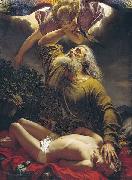 |
Gerhard Wilhelm von Reutern -- Click Here
|
|
painted Abraham sacrificing Isaac in 1849 |
|
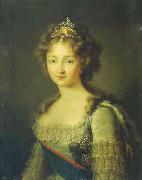 |
Gerhard von Kugelgen -- Click Here
|
|
Franz Gerhard von Kegelgen (February 26, 1772 - March 27, 1820) was a German painter, noted for his portraits and history paintings. He was a professor at the Academy of Arts in Dresden and a member of both the Prussian and Russian Academies of Arts. His twin brother, Karl von Kegelgen, was also a painter of note.
Gerhard von Kegelgen was born at Bacharach am Rhein. After leaving school in 1789, he studied painting in Koblenz. Beginning in 1791, he worked in Bonn, where he painted portraits of Elector Archduke Maximilian Franz of Austria, minister Ferdinand August von Spiegel zum Desenberg, and the Earl of Waldstein. Afterwards, Gerhard von Kegelgen and his brother undertook an educational journey to Rome, Munich and Riga, which was financed by Maximilian Franz of Habsburg.
In 1800, Kegelgen married Helene Marie Zoege von Manteuffel. They had three children together. His first son, Wilhelm was born in Saint Petersburg in 1802, and also grew up to become a painter. The other children were Gerhard (born 1806), and Adelheid (born 1808).
|
|
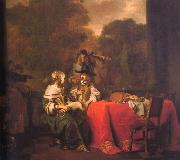 |
Gerbrand van den Eeckhout -- Click Here
|
|
1621-1674
Dutch
Gerbrand van den Eeckhout Location
Dutch painter, draughtsman and etcher. He was the son of the goldsmith Jan Pietersz. van den Eeckhout and a great friend as well as a pupil of Rembrandt, according to Houbraken, who commented that van den Eeckhout painted in the style of his master throughout his career. This is certainly true of van den Eeckhout (biblical) history paintings, but less so of either his portraits, which gradually displayed more Flemish elegance, or his genre pieces (from 1650), in which he followed various trends; he adapted his style to suit his subject with sensitive versatility. He was also a gifted colourist and an artist of great imagination, superior in both these respects to such better-known Rembrandt pupils as Ferdinand Bol and Nicolaes Maes. Moreover, he was extremely productive, and there is at least one dated painting for virtually every year between 1641 and 1674. In addition, he created a large body of drawings comprising histories, figures, landscapes and genre scenes executed in various media, including watercolour. He also made several etchings, mostly studies of heads, such as the Self-portrait (1646; B. 66). He died a bachelor, aged 53. |
|
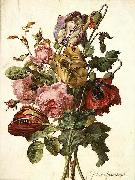 |
Gerard van Spaendonck -- Click Here
|
|
(22 March 1746 - 11 May 1822) was a Dutch painter.
Gerard was born in Tilburg, an older brother of Cornelis van Spaendonck (1756-1840), who was also a renowned artist. In the 1760s he studied with decorative painter Willem Jacob Herreyns (also known as Guillaume-Jacques Herreyns) (1743-1827) in Antwerp. In 1769 he moved to Paris, and in 1774 was appointed miniature painter in the court of Louis XVI. In 1780 he succeeded Madeleine Françoise Basseporte (1701-1780) as professor of floral painting at the Jardin des Plantes, and shortly afterwards was elected a member of the Academie des beaux-arts.
Gerard van Spaendonck painted with both oil and watercolors. He contributed over fifty works to the Velins du Roi, which was a famous collection of botanical watercolors possessed by French royalty. From 1799 to 1801 he published twenty-four plates of his Fleurs Dessinees d'apres Nature (Flowers Drawn from Life), which were high-quality engravings for students of floral painting. Today, Fleurs Dessinees d'apres Nature is a highly treasured book on floral art.
In 1788 Spaendonck was appointed adviser to the Academie, and in 1795 he became a founding member of the Institut de France. In 1804 he received the Legion d'honneur and soon afterwards was ennobled by Napoleon Bonaparte. He died in Paris.
|
|
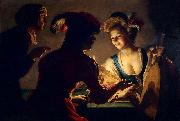 |
Gerard van Honthorst -- Click Here
|
|
(November 4, 1592 - April 27, 1656), also known as Gerrit van Honthorst and Gherardo della Notte, was a Dutch painter of Utrecht. He was brought up at the school of Abraham Bloemaert, who exchanged the style of the Franckens for that of the pseudo-Italians at the beginning of the 16th century.
Margareta Maria de Roodere and Her Parents by Gerrit van Honthorst (1652) Oil on canvas, 140 x 170 cm. Centraal Museum, UtrechtInfected thus early with a mania which came to be very general in the Netherlands, Honthorst went to Italy in 1616, where he copied the naturalism and eccentricities of Michelangelo da Caravaggio. Home again about 1620, after acquiring a considerable practice in Rome, he set up a school at Utrecht which flourished exceedingly. Together with his colleague Hendrick ter Brugghen, he represented the so-called Dutch Caravaggisti. In 1623 he was president of his gild at Utrecht, where he had married his cousin. He soon became so fashionable that Sir Dudley Carleton, then English envoy at The Hague, recommended his works to the earl of Arundel and Lord Dorchester. In 1626 he received a visit from Rubens, whom he painted as the honest man sought for and found by Diogenes. |
|
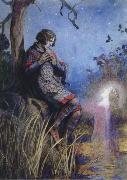 |
George Edmund Varian -- Click Here
|
|
American Artist 1865-1923
|
|
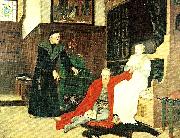 |
georg von rosen -- Click Here
|
|
Johan Georg Otto von Rosen, född 13 februari 1843 i Paris, död 1923 i Stockholm, var en svensk konstnär och greve av ätten von Rosen. Han målade i den akademiska stilen, till stor del historiemåleri och porträtt. Han var professor vid Konstakademien 1880-1908 och dess direktör 1881-1887 samt 1893-1899. Som konstakademiens direktör kom han i stark konflikt med den nya generation av konstnärer som krävde reformer av akademiens utbildning och utställningsverksamhet, de så kallade opponenterna.
Georg von Rosen föddes i Paris 1843 som son till generalkonsuln greve Adolf Eugene von Rosen (kallad "de svenska järnvägarnas fader") och hans hustru Euphrosyne Rizo-Rangabe. Hans första levnadsår förflöt i Paris, varifrån familjen flydde till Sverige under februarirevolutionen 1848. Han studerade 1855-1861 vid Konstakademien i Stockholm. 1862 besökte Rosen världsutställningen i London där han lärde känna belgaren Henri Leys' arbeten, målningar med scener från medeltiden och renässansen målade i ålderdomlig stil. Dessa verk gjorde ett stort intryck på von Rosen. Han skrev själv
Stående hvarje dag i flere timmar, försjunken i åskådandet af dessa om en snart sagdt öfvermänsklig intuition vittnande bilder, som likväl flertalet i den stora hopen med likgiltighet skred förbi, drömde jag mig tillbaka in i en hänsvunnen tid och för mina yttre ögon försvann hela den öfriga utställningen, den omgifvande mängden, ja hela den existerande verlden! Då jag lemnade London, var jag på 14 dagar vorden 300 år äldre.
Rosen uppsökte följande året mästaren i Antwerpen och tillbringade en tid i hans umgänge och i hans atelje. Återkommen till Sverige, inspirerad av mötet, målade han Sten Sture d.ä. intåg i Stockholm. Den medeltida stadsmiljön med det noggranna återgivandet av stenläggningen och den närmast osannolika rikedomen på byggnadsdetaljer känns igen från Leys målningar. von Rosen belönades med kunglig medalj för målningen, och blev hyllad och uppskattad av Oscar II på grund av bildspråket, som i hög grad uttryckte den oscarianska epokens ideal. Samma år begav han sig ut på resa och besökte Egypten, Palestina, Syrien, Osmanska riket, Grekland och Ungern där han studerade måleri. 1866 vistades han ett år i Rom och vistades sedan åter hos Leys fram till dennes död 1869. Därefter studerade han i Menchen under Karl Piloty och reste sedan vidare till Italien innan han återkom till Sverige 1871. Efter hemkomsten målade han Erik XIV och Karin Månsdotter.
1872 blev han ledamot av Konstakademien, 1874 blev han vice professor, 1879 kammarherre och 1880 professor i figurteckning och målning. 1881-1887 samt 1893-1899 var han direktör för Akademins läroverk. 1892-1900 var han även ordförande i Nordiska samfundet till bekämpande av det vetenskapliga djurplågeriet, numera Djurens Rätt.
Han avled 1923 och förblev ogift under hela sitt liv. |
|
|
|
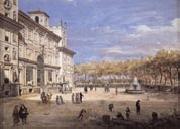 |
Gaspar Van Wittel -- Click Here
|
|
Dutch Baroque Era Painter, ca.1653-1736
was a Dutch landscape painter. Van Wittel learned painting in his hometown of Amersfoort. His first extant works were made in Hoorn in 1672, but he relocated to Rome with his family ca. 1675 and made his career there. In Amersfoort, he likely was exposed to Dutch landscape artists such as Jan van der Heyden and Gerrit Berckheyde. He married in Rome in 1697, and stayed most of his life in that city, though, between 1694 and 1710, he toured Italy and painted in places like Florence, Bologna, Ferrara, Venice, Milan, Piacenza and Naples. He is one of the principal painters of topographical views known as vedute. His son Luigi would become a famous architect and also carries the italianized family name of Vanvitelli. In Luigi's biography is written that his father was born in July 1656, |
|
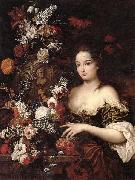 |
Gaspar Peeter Verbrugghen the younger -- Click Here
|
|
Flemish ,
Antwerp 1664-1730
|
|
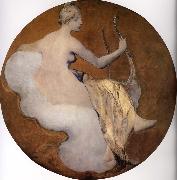 |
Galland Pierre Victor -- Click Here
|
|
Geneve 1822-Paris 1892
He studied metalwork with his father Jacques Galland, an accomplished goldsmith, until age 16. He then entered the studio of Henri Labrouste to study architecture. After two years of training, Labrouste encouraged him to pursue his interest in decorative painting under the direction of Michel-Martin Drolling. In 1843 the decorative painter Pierre-Luc-Charles Ciceri (1782-1868) hired Galland to assist with the painting of figures, flowers, garlands and fruit. He worked again with Labrouste, in 1848, on the decoration of the national festival, the F?te de la Concorde. |
|
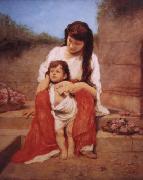 |
Gabriel von Max -- Click Here
|
|
(August 23, 1840 - November 24, 1915) was a Prague-born Austrian painter.
He was born Gabriel Cornelius Max, the son of Czech sculptor Joseph Max and Anna Schumann. He studied between 1855 and 1858 at the Prague Academy of Arts with Eduard von Engerth. His studies included parapsychology (somnambulism, hypnotism, spiritism), Darwinism, Asiatic philosophy, the ideas of Schopenhauer, and various mystical traditions. The spiritual-mystical movement was emphasized by the writings of Carl du Prel, and the Munich painter Albert Keller was also an influence.
His first large canvas was painted in 1858 while he was a student at the Prague Academy. He continued his studies at the Viennese Academy of Art with Karl von Blaas, Karl Mayer, Christian Ruben and Carl Wurzinger. From 1863 to 1867 he studied at the Munich Academy with Karl Theodor von Piloty, and also Hans Makart and Franz Defregger. His first critical success was in 1867 with the painting "Martyr at the Cross": that painting transformed the "Ungl?-ksmalerei" (dark palette) of Piloty into a religious-mystical symbolism using a psychological rendering of its subject.
He continued to use the dark palette of the Piloty school well into the 1870s, later moving toward a more muted palette, using fewer,clearer colors. From 1869, Gabriel von Max had his studio in Munich; in the summer, he was in the Ammerland at Starnberger Lake. From 1879-1883, Gabriel Max was a professor of Historical Painting at the Munich Academy; he also became a Fellow of The Theosophical Society. In 1900 he was ennobled and became a Ritter. He died in Munich in 1915.
His interest in anthropological studies also showed in his work. He owned a large scientific collection of prehistoric ethnological and anthropological finds: the collection now resides in the Stadtischen Reiss Museum in Mannheim. At his residence in Starnberger Lake, Gabriel Max surrounded himself with a family of monkeys, which he painted often, sometimes portraying them as human. Max, along with his colleagues, often used photographs to guide painting. The great number of monkey photographs in his archive testify to their use as direct translation into his paintings. In 1908, his painting "The Lion's Bride" became celebrated, and was depicted in motion pictures as an hommage in the Gloria Swanson film, Male and Female, (1919), directed by Cecil B. de Mille.
Gabriel von Max was a significant artist to emerge from the Piloty School, because he abandoned the themes of the Grunderzeitliche (genre and history), in order to develop an allegorical-mystical pictorial language, which became typical of Secessionist Art. Characteristic of the ethereal style of Gabriel Max is "The Last Token" (in the Metropolitan Museum), and "Light" (in the Odessa Museum of Western and Eastern Art, Ukraine).
|
|
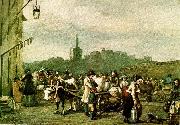 |
fritz von dardel -- Click Here
|
|
Fritz Ludvig von Dardel, född den 24 mars 1817 i Neuchâtel, död den 27 maj 1901 i Stockholm, var en schweiziskfödd svensk överintendent, militär, målare och tecknare.
Fritz von Dardel var son till godsägaren Georges-Alexandre von Dardel och grevinnan Hedvig Sofia Charlotta Amalia Lewenhaupt. Han var gift med friherrinnan Augusta Silfverschiöld. Släkten von Dardel kommer från Schweiz och adlades i Sverige 1810.
Von Dardel blev vid sexton års ålder konstapelkadett vid Vendes artilleriregemente, 1837 underlöjtnant vid Svea livgarde och avancerade till överstelöjtnant i armen 1862. Han blev 1850 adjutant hos kronprinsen och sedan hos Karl XV. Von Dardel var 1858-62 militärattach?? i Paris samt blev 1864 kabinettskammarherre hos Karl XV och samma år överintendent och ordföranden i Akademin för de fria konsterna, av vilken han 1861 invalts till hedersledamot. Dessutom var han ordförande i Nationalmuseums nämnd i 25 år (1867-92).
Vid flera konstutställningar i Europa (1867, 1871, 1873 och 1878) samt i Philadelphia (1876) var han juryman.
Själv hade von Dardel bedrivit studier på L??on Cogniets och E. Lamis ateljeer i Paris.
Fritz von Dardel tillhörde Karl XV:s intima krets och har gjort ett flertal dråpliga, akvarellerade teckningar av personer och händelser vid hovet eller under kungens resor, vidare folklivsbilder samt litografier. Hans dagböcker (se nedan) som utgavs postumt är skrivna på franska och översatta och redigerade av hans söner. |
|
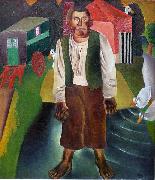 |
Frits Van den Berghe -- Click Here
|
|
(3 April 1883 - 22 September 1939) was a Belgian expressionist painter.
He was born at Ghent. Like his friends Constant Permeke and Gustave De Smet, he first adopted the late-impressionist style of Emile Claus, but converted to expressionism during World War I.
|
|
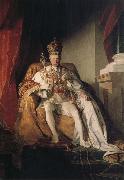 |
Friedrich von Amerling -- Click Here
|
|
Austrian Academic Painter, 1803-1887,Austrian painter. He came from a family of craftsmen and studied (1815-24) at the Akademie der bildenden Kenste, Vienna, where one of his teachers was the conservative history painter Hubert Maurer (1738-1818). From 1824 to 1826 he attended the Academy in Prague, where he was taught by Josef Bergler. In 1827 and 1828 Amerling stayed in London, and he met the portrait painter Sir Thomas Lawrence, whose work was to be a strong influence on Amerling's painting during the next two decades. Amerling also travelled to Paris and Rome but was recalled to Vienna on an official commission to paint a life-size portrait of the emperor Francis I of Austria (Vienna, Ksthist. Mus.). With this work, |
|
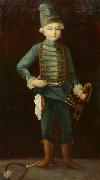 |
Friedrich August von Kaulbach -- Click Here
|
|
(2 June 1850, Hannover - 26 July 1920, Munich, Germany) was a German portraitist and historical painter. He was the son of Theodor Friedrich Wilhelm Christian Kaulbach (1822 - 1903), the court painter at Hannover, and the great nephew of Wilhelm Kaulbach, another prominent member of the Kaulbach family of artists. He learned to paint from his father, and later was a student of August von Kreling at Nuremberg. He sought to emulate the artist Hans Holbein. |
|
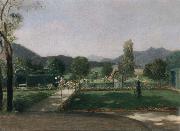 |
Friedrich August von Kaulabch -- Click Here
|
|
Munich 1850-1920 Ohlstadt
|
|
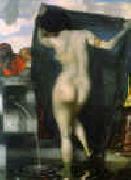 |
Franz von Stuck -- Click Here
|
|
German Symbolist/Expressionist Painter and Sculptor, 1863-1928
Stuck was born at Tettenweis, in Bavaria. From an early age he displayed an affinity for drawing and caricature. To begin his artistic education in 1878 he went to Munich, where he would settle for life. From 1881 to 1885 Stuck attended the Munich Academy.
He first made a name with cartoons for Fliegende Blätter, and vignette designs for programmes and book decoration. In 1889 he exhibited his first paintings at the Munich Glass Palace, winning a gold medal for The Guardian of Paradise.
In 1892 Stuck co-founded the Munich Secession, and also executed his first sculpture, Athlete. The following year he won further acclaim with the critical and public success of what is now his most famous work, The Sin. Also in 1893, Stuck was awarded a gold medal for painting at the Chicago World's Fair and was appointed to a royal professorship. In 1895 he began teaching painting at the Munich Academy.
In 1897 Stuck married an American widow, Mary Lindpainter, and began work designing his own residence and studio, the Villa Stuck. His designs for the villa included everything from layout to interior decorations; for his furniture Stuck received another gold medal at the 1900 Paris World Exposition.
Having attained a high degree of fame by this time, Stuck was elevated to the aristocracy on December 9, 1905 and would receive further public honours from around Europe during the remainder of his life. Even as new trends in art left Stuck behind, he continued to be highly respected among young artists in his capacity as professor at the Munich Academy. Notable students of his over the years include Paul Klee, Hans Purrmann, Wassily Kandinsky, and Josef Albers.
Franz von Stuck died in 1928; his funeral address memorialized him as "the last prince of art of Munich's great days". He is buried in the Munich Waldfriedhof next to his wife Mary. |
|
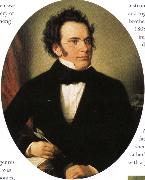 |
franz von schober -- Click Here
|
|
was a student in Vienna, where he met F. Schubert, E. Bauernfeld, and M. von Schwind. He is the author of twelve poems set to music by Schubert between 1815 and 1827, of which the best known is An die Musik (Du holde Kunst). In later life Schober was a secretary of legation (Legationsrat) in Weimar. |
|
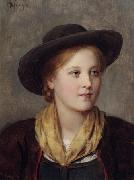 |
Franz von Defregger -- Click Here
|
|
(after 1883 Franz von Defregger) (30 April 1835 - 2 January 1921) was an Austrian artist known mostly for his genre and history paintings.
He was born in Ederhof at Stronach, in Tyrol, the son of a prosperous farmer. In 1860, following his father's death, Franz sold the family's farm and went to Innsbruck, where he studied with the sculptor Michael Stolz. He went to Munich in 1861 to study under Hermann Dyck and Hermann Anschetz. In 1863 he travelled to Paris, where he continued his artistic education autodidactically by a routine of figure drawing and a thorough study of the museums, art collections and studios. On 8 July 1865 he returned to Munich, where from 1867 to 1870 he studied alongside Hans Makart and Gabriel Max in the studio of history painter Karl von Piloty.
Defregger became one of the leading genre painters in Munich, and became a professor of history painting at the Munich Academy, where he continued to teach until 1910. He died in Munich in 1921. |
|
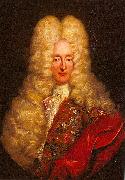 |
Frans van Stampart -- Click Here
|
|
Belgium (1675 -1750 ) - Painter |
|
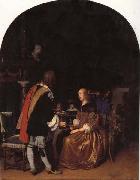 |
Frans van mieris the elder -- Click Here
|
|
Dutch Baroque Era Painter, 1635-1681
was a Dutch genre and portrait painter. The leading member of a Leiden family of painters, his sons Jan (1660-1690) and Willem (1662 C1747) and his grandson Frans van Mieris the Younger (1689 C1763) were also accomplished genre painters. Frans was the son of Jan Bastiaans van Mieris, a goldsmith, carver of rubies and diamond setter at Leiden. His father wished to train him to his own business, but Frans preferred drawing, and took service with Abraham Torenvliet, a glazier who kept a school of design. In his father's shop he became familiar with the ways and dress of people of distinction. His eye was fascinated in turn by the sheen of jewelry and stained glass; and, though he soon gave up the teaching of Torenvliet for that of Gerard Dou and Abraham van den Tempel, he acquired a manner which had more of the finish of the exquisites of the Dutch school than of the breadth of the disciples of Rembrandt. It should be borne in mind that he seldom chose panels of which the size exceeded 12 to 15 inches, and whenever his name is attached to a picture above that size we may surely assign it to his son Willem or to some other imitator. Unlike Dou when he first left Rembrandt, or Jan Steen when he started on an independent career, Mieris never ventured to design figures as large as life. Characteristic of his art in its minute proportions is a shiny brightness and metallic polish. The Music Lesson,National Museum of Serbia , BelgradeThe subjects which he treated best are those in which he illustrated the habits or actions of the wealthier classes; but he sometimes succeeded in homely incidents and in portrait, and not unfrequently he ventured on allegory. He repeatedly painted the satin skirt which Ter Borch brought into fashion, and he often rivalled Ter Borch in the faithful rendering of rich and highly-coloured woven tissues. But he remained below Ter Borch and Metsu, because he had not their delicate perception of harmony or their charming mellowness of touch and tint, and he fell behind Gerard Dou, because he was hard and had not his feeling for effect by concentrated light and shade. In the form of his composition, which sometimes represents the framework of a window enlivened with greenery, and adorned with bas-reliefs within which figures are seen to the waist, his model is certainly Dou. |
|
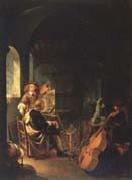 |
Frans van Mieris -- Click Here
|
|
Dutch Baroque Era Painter, 1635-1681 |
|
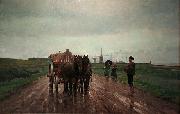 |
Frans van Leemputten -- Click Here
|
|
painted Aan de Schelde-arm in 1884 |
|
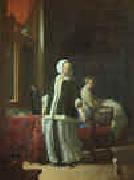 |
Frans Jansz van Mierisi -- Click Here
|
|
1635-1681
Dutch
Frans Jansz van Mierisi Gallery |
|
 |
Frans Floris de Vriendt -- Click Here
|
|
c.1517-70, Flemish painter |
|
|
|
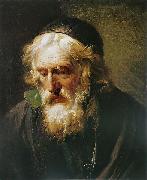 |
Francois-Andre Vincent -- Click Here
|
|
(December 30, 1746 - August 4, 1816) was a French neoclassical painter.
He was the son of the miniaturist François-Elie Vincent and studied under Joseph-Marie Vien. He travelled to Rome, where he won the Prix de Rome in 1768. From 1771 to 1775 he studied there at the Academie de France.
In 1790 Vincent was appointed master of drawings to Louis XVI of France, and in 1792 he became a professor at the Academie royale de peinture et de sculpture in Paris. In 1800 he married the painter Adelaïde Labille-Guiard.
Belisarius by François-Andre Vincent, painted 1776. He was a leader of the neoclassical and historical movement in French art, along with his rival Jacques-Louis David, another pupil of Vien. He was influenced by the art of classical antiquity, by the masters of the Italian High Renaissance, especially Raphael, and among his contemporaries, Jean-Honore Fragonard.
He was one of the founder members of the Academie des beaux-arts part of the Institut de France and the successor to the Academie royale in 1795. |
|
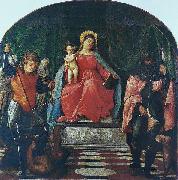 |
Francesco Vecellio -- Click Here
|
|
(c. 1475 - 1560) was an Italian painter of the early Renaissance, best known as the elder brother of the painter Titian. In his youth, he was a soldier. As a painter, he was mainly active in 1520-1530s in Cadore. In 1524, he signed an altarpiece for San Vito in Cadore. In 1540s, he painted a polyptych at Candide. In late 1540s he painted the organ shutters of San Salvatore in Venice. He painted an Annunciation for San Nicola di Bari, now in the Accademia.
|
|
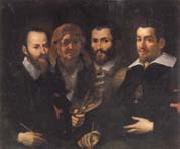 |
Francesco Vanni -- Click Here
|
|
Italian Baroque Era Painter, 1563-1610
was an Italian painter of the Mannerist style, active in Rome and his native city of Siena. He was half-brother of the painter Ventura Salimbeni, and the stepson of Arcangelo Salimbeni, another Sienese painter. His stepfather died when Francesco was young, and as a 16 year old went first to Bologna, then to Rome. There he apprenticed with Giovanni de' Vecchi during 1579-80, though like other Tuscan painters of his day, he was influenced in part by Federico Barocci from Urbino, and he was among the last painters who also reflected the influence of the Sienese School of painting. He was named a Cavalieri. In Rome, he worked later with Salimbeni, Bartolomeo Passerotti, and Andrea Lilio. He was commissioned by Pope Clement VIII to painted an altarpiece for the St. Peter's, later transferred to mosaic, Simon Magus rebuked by St. Peter. He painted several other pictures for Roman churches; including St. Michael defeats rebel angels for the sacristy of S. Gregorio; a Piet?? for Santa Maria in Vallicella; and the Assumption for S. Lorenzo in Miranda. Returning to Siena, where he ultimately died, he afterwards worked at Parma, Bologna, and again at Rome. At Siena, he painted a S. Raimondo walking on the Sea for the church of the Dominicans. Vanni painted a Baptism of Constantine (1586-7) for the church of San Agostino in Siena. He painted a Christ appearing to St. Catherine for the chapel of il Refugio at the Santuario Cateriniano of Siena, and a Baptism (1587) for the former church of San Giovannino e Gennaro. |
|
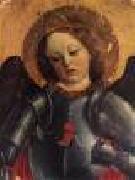 |
FOPPA, Vincenzo -- Click Here
|
|
Italian Early Renaissance Painter, ca.1430-1515
was a Northern-Italian Renaissance painter. He was an elderly contemporary of Leonardo da Vinci. Born at Bagnolo Mella, near Brescia in the Republic of Venice, he settled in Pavia around 1456, serving the dukes of Milan and emerging as one of the most prominent Lombard painters. Foppa returned to Brescia in 1489. His style shows affinities to Andrea del Castagno and Carlo Crivelli. Vasari claimed he had trained in Padua, where he may have been strongly influenced by Mantegna. During his lifetime, he was highly acclaimed, especially for his skill in perspective and foreshortening. His important works include a fresco in the Brera Gallery of Milan, the Martyrdom of St. Sebastian, and a Crucifixion (1435) in the Accademia Carrara of Bergamo. Many of his works have been lost. He was influential in the styles of Vincenzo Civerchio and Girolamo Romanino.
|
|
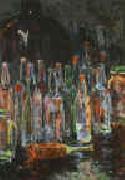 |
Floris Verster -- Click Here
|
|
1861-1927
Dutch
Floris Verster Gallery
Dutch painter. He trained first at the Ars Aemula Naturae school in Leiden under George Hendrik Breitner, then at The Hague Academie (1879-82) and the Brussels Academie (1882). In Leiden in 1882 he started painting landscapes in the style of the Hague school. From 1882 to 1892 he shared a studio in Leiden with the still-life painter Menso Kamerlingh Onnes (1860-1925), who was to become his brother-in-law. Influenced by Onnes and such French realists as Antoine Vollon and Theodule Ribot, in 1885 he turned to painting still-lifes in a mildly Impressionist style that by 1888-9 often attained monumental formats, as in Peonies (1.35*2.00 m, 1889; Amsterdam, Stedel. Mus.). He submitted some of these to exhibitions, where their reception was mixed; artists including Breitner, H. W. Mesdag and Jacob Maris were enthusiastic, but the critics quite often were not. He participated in a few exhibitions abroad, notably from 1890 to 1894 in Munich and in 1891 with Les XX in Brussels. |
|
 |
Floris van Schooten -- Click Here
|
|
(1590-1655), was a Dutch Golden Age still life painter.
According to the RKD, Van Schooten was the son of a leading Catholic family of Amsterdam who came to live in Haarlem in 1612. During that period, many Catholic families left Amsterdam where the Protestants had the upper hand in local government, for Haarlem, where the climate for Catholicism was more tolerant. The young Van Schooten became a member of the Haarlem Guild of St. Luke and married the daughter of a leading beer brewer there, Rycklant Bol van Zanen. Together they had 3 daughters and a son Johannes, who also became a painter |
|
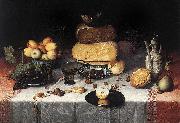 |
Floris van Dyck -- Click Here
|
|
, also called Floris van Dijck or Floris Claesz. van Dyck (Delft or Haarlem, c. 1575 - Haarlem, before 26 April 1651), was a Dutch Golden Age still life painter.
He lived in Haarlem for most of his life, but he was born in Delft. He was a cousin of Pieter Cornelisz van Dijck. In 1600 he is documented as being in Rome, indicating he made a journey to Italy. In 1606 he returned to the Netherlands, where he joined the Haarlem Guild of St. Luke in 1610 and became dean in 1637. He was influenced by Osias Beert and Clara Peeters. He is considered the inventor of the banketje (banquet still life genre similar to breakfasts, or ontbijtjes), together with Nicolaes Gillis. |
|
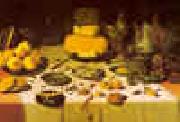 |
Floris van Dijck -- Click Here
|
|
Dutch Baroque Era Painter, 1575-1651
Dutch painter and draughtsman. He is thought to have been a pupil of Rembrandt in Amsterdam c. 1650. There is no documentary evidence for this, but his earliest dated painting, the Presentation in the Temple shows that he had certainly seen examples of Rembrandt work. He was an eclectic artist, given to following several models simultaneously. This is evident from two versions of Elijah and the Widow of Zarephath; one (1655-60; Copenhagen, Stat. Mus. Kst) is painted in horizontal format in the style of Barent Fabritius, while the other (1655-60; Milwaukee, WI, A. Bader priv. col., see Sumowski, 1983, no. 362) features large half-length figures in the manner of Nicolaes Maes. In another biblical scene, Benjamin and Judah (1655-60; Chicago, IL, A. Inst.), he followed the example of Rembrandt. His best works, such as Saying Grace (1655-60; Hannover, Nieders?chs. Landesmus.) and the Old Prophetess (1655-60; Leipzig, Mus. Bild. Kst), show old women either praying or sleeping and confirm that Maes was his main source of inspiration. Similar subjects are represented in the drawings attributed to him (e.g. Old Woman Seated, Holding a Book; New York, Pierpont Morgan Lib.). In the late 1650s van Dijck also seems to have been influenced by the genre paintings of Gabriel Metsu and above all by Quiringh van Brekelenkam, as in Hermit Praying in a Cave (late 1650s; St Petersburg, Hermitage) and Family Saying Grace (late 1650s; Stockholm, Nmus.). |
|
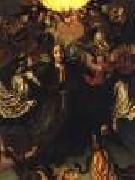 |
FERNANDES, Vasco -- Click Here
|
|
Portuguese painter (active 1500-1542 in Viseu)
Portuguese painter. He was the leading painter of northern Portugal during the first half of the 16th century, and it is probable that he received his training abroad. Fernandes is the best-documented Portuguese artist of the period; there are nearly 100 works attributed to him, some of which are securely documented and record his activity either alone or in collaboration with the Viseu painter GASPAR VAZ. Fernandes's most important work was carried out in Lamego and in Viseu, where the term Gr?o ('Great') used in praise of him is first recorded (Ribeiro Botelho Pereira). In 1753 the Director of the Dresden Gallery, Pietro Guarienti, first used the epithet when he referred to Fernandes by the name of Gran Vasco. The many myths about the painter and his work developed from this date and were not clarified until 1846 |
|
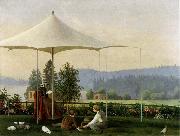 |
Ferdinand von Wright -- Click Here
|
|
1822-1906,Brother of Magnus von Wright and Wilhelm von Wright. He grew up under the influence of his brothers and became a skilled ornithological illustrator at a very young age. He remained in Sweden from 1837 until 1844 and worked as a draughtsman, helping his brother Wilhelm. After returning to Finland he set his sights on a career as a painter. During the second half of the 1840s he was still searching for his proper path, and he experimented with a number of subjects: birds, still-lifes, landscapes and portraits. |
|
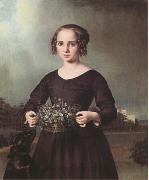 |
Ferdinand von Rayski -- Click Here
|
|
1806-1890
was a German painter noted for his portraits. Rayski was born in 1806 in Pegau. From 1816 to 1821 he studied drawing under Traugott Faber at the Freimaurerinstitut in Dresden and from 1823 to 1825 studied at Kunstakademie in Dusseldorf. He began his career as a professional artist in 1829, painting portraits of his noble relatives in Hannover and Silesia. From 1831 to 1834 he lived in Dresden, where he received numerous portrait commissions. He traveled to Paris in 1834-35, and was influenced by the works of Delacroix, Gericault and Gros. Rayski gained a reputation as a distinguished portrait painter, but also produced animal and hunting scenes, as well as, yet less frequently, military, historical and mythological paintings. |
|
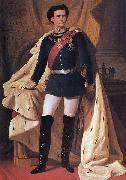 |
Ferdinand von Piloty -- Click Here
|
|
painted King Ludwig II of Bavaria in generals' uniform and coronation robe in 1865 |
|
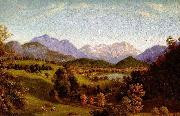 |
Ferdinand von Olivier -- Click Here
|
|
painted Loisachtal in 1842-1845
|
|
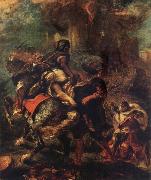 |
Ferdinand Victor Eugene Delacroix -- Click Here
|
|
Charenton Saint Maurice 1798-Paris 1863,was a French Romantic artist regarded from the outset of his career as the leader of the French Romantic school. Delacroix's use of expressive brushstrokes and his study of the optical effects of colour profoundly shaped the work of the Impressionists, while his passion for the exotic inspired the artists of the Symbolist movement. A fine lithographer, Delacroix illustrated various works of William Shakespeare, the Scottish writer Sir Walter Scott, and the German writer Johann Wolfgang von Goethe. In contrast to the Neoclassical perfectionism of his chief rival Ingres, Delacroix took for his inspiration the art of Rubens and painters of the Venetian Renaissance, with an attendant emphasis on color and movement rather than clarity of outline and carefully modeled form. Dramatic and romantic content characterized the central themes of his maturity, and led him not to the classical models of Greek and Roman art, but to travel in North Africa, in search of the exotic.Friend and spiritual heir to Theodore Gericault, |
|
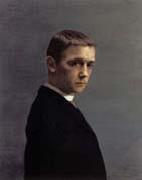 |
Felix Vallotton -- Click Here
|
|
1865-1925was a Swiss painter and printmaker associated with Les Nabis. He was an important figure in the development of the modern woodcut. He was born into a conservative middle class family in Lausanne, and there he attended College Cantonal, graduating with a degree in classical studies in 1882. In that year he moved to Paris to study art under Jules Joseph Lefebvre and Gustave Boulanger at the Academie Julian. He spent many hours in the Louvre, where he greatly admired the works of Holbein, Derer and Ingres; these artists would remain exemplars for Vallotton throughout his life.[1] His earliest paintings, such as the Ingresque Portrait of Monsieur Ursenbach (1885), are firmly rooted in the academic tradition, and his self portrait of 1885 (seen at right) received an honorable mention at the Salon des artistes français in 1886. During the following decade Vallotton painted, wrote art criticism and made a number of prints. In 1891 he executed his first woodcut, a portrait of Paul Verlaine. The many woodcuts he produced during the 1890s were widely disseminated in periodicals and books in Europe as well as in the United States, and were recognized as radically innovative in printmaking. They established Vallotton as a leader in the revival of true woodcut as an artistic medium; in the western world, the relief print, in the form of commercial wood engraving, had long been mainly utilized unimaginatively as a medium for the reproduction of drawn or painted images and, latterly, photographs. Vallotton's starkly reductive woodcut style features large masses of undifferentiated black and areas of unmodulated white. While emphasizing outline and flat patterns, Vallotton generally made no use of the gradations and modeling traditionally produced by hatching. The influences of post-Impressionism, symbolism and the Japanese woodcut are apparent; a large exhibition of ukiyo-e prints had been presented at the École des Beaux-Arts in 1890, and Vallotton, like many artists of his era an enthusiast of Japonism, collected these prints. He depicted street crowds and demonstrations including several scenes of police attacking anarchists bathing women, portrait heads, and other subjects which he treated with a sardonic humor. His graphic art reached its highest development in Intimit's (Intimacies), a series of ten interiors published in 1898 by the Revue Blanche, which deal with tension between men and women. Vallotton's prints have been suggested as a significant influence on the graphic art of Edvard Munch, Aubrey Beardsley, and Ernst Ludwig Kirchner .By 1892 he was affiliated with Les Nabis, a group of young artists that included Pierre Bonnard, Ker-Xavier Roussel, Maurice Denis, and Edouard Vuillard, with whom Vallotton was to form a lifelong friendship. During the 1890s, when Vallotton was closely allied with the avant-garde, his paintings reflected the style of his woodcuts, with flat areas of color, hard edges, and simplification of detail. |
|
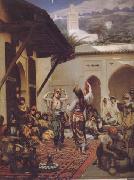 |
Felix de vuillefroy -- Click Here
|
|
French, 1841-1910 |
|
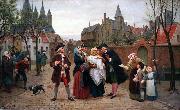 |
Felix de Vigne -- Click Here
|
|
(16 March 1806 - 5 December 1862) was a Belgian painter.
De Vinge was a history painter, engraver, art historian, and instructor at the Royal Academy of Fine Arts (Ghent). In 1847 he published Recherches historiques sur les costumes civils et militaires, an illustrated compendium of the flags, shields and costumes of medieval guilds and military groups.
He was the brother of sculptor Pieter De Vigne (1812-1877), father of Brussels architect Edmond De Vinge (1841-1918), and the stepfather of painter Jules Breton.
|
|
 |
Felix Vallotton -- Click Here
|
|
French
1865-1925
Felix Vallotton Gallery
Swiss woodcut artist and painter. Associated with the Nabis, he worked in Paris. Vallotton rejuvenated the woodcut medium as a creative technique. His boldly cut designs, conceived as arrangements in black and white, depict Parisian society with wit and intelligence. A painting, Swiss Landscape, is in the Lyman Allyn Museum, New London, |
|
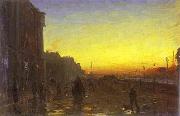 |
Fedor Vasilyev -- Click Here
|
|
painted Dawn in St. Petersburg |
|
|
|
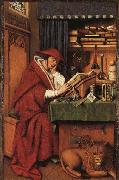 |
EYCK, Jan van -- Click Here
|
|
Flemish Northern Renaissance Painter, ca.1395-1441
Painter and illuminator, brother of Hubert van Eyck. According to a 16th-century Ghent tradition, represented by van Vaernewijck and Lucas d'Heere, Jan trained with his brother Hubert. Pietro Summonte's assertion (1524) that he began work as an illuminator is supported by the fine technique and small scale of most of Jan's works, by manuscript precedents for certain of his motifs, and by his payment in 1439 for initials in a book (untraced) for Philip the Good, Duke of Burgundy. Jan is first documented in The Hague in August 1422 as an established artist with an assistant and the title of 'Master', working for John III, Count of Holland (John of Bavaria; reg 1419-25), who evidently discovered the artist while he was bishop (1389-1417) of the principality of Liege. |
|
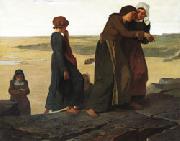 |
Evariste Vital Luminais -- Click Here
|
|
(October 13, 1822 - 1896) was a French painter.
He was born in Nantes. He scored a success at the Paris Salon of 1884 with the painting Flight of King Gradlon. Another Luminais' important painting is The Sons of Clovis II.
|
|
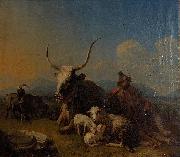 |
Eugne Joseph Verboeckhoven -- Click Here
|
|
(1790-1881), Belgian painter, was born at Warneton in West Flanders, and received instruction in drawing and modelling from his father, the sculptor Barthelemy Verboeckhoven. Subsequently he settled in Brussels and devoted himself almost exclusively to animal subjects.
Shepherd with animals in the countryside
attributed to Eugene Verboeckhoven - private collectionHis paintings of sheep, of horses and of cattle in landscape, somewhat after the manner of Paulus Potter, brought him universal fame, and were eagerly sought for by collectors. Precise and careful finish is the chief quality of his art, which is entirely objective and lacking in inspiration. Verboeckhoven visited England in 1826, Germany in 1828, and France and Italy in 1841, and died at Brussels in 1881. He was a member of the academies of Brussels, Ghent, Antwerp, St. Petersburg and Amsterdam. Examples of his art are to be found in nearly all the important galleries of Europe and the United States, notably in Brussels, Antwerp, Amsterdam, Hamburg, Berlin, Munich, New York, Boston and Washington D.C.. His long life and ceaseless industry account for the enormous number of his pictures in public and private collections and in the art market. In addition to his painted work he executed some fifty etched plates of similar subjects.
|
|
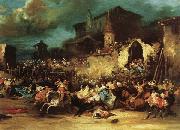 |
Eugenio Lucas Velazquez -- Click Here
|
|
Madrid artist , 1817-1870
|
|
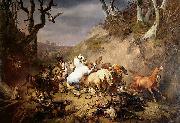 |
Eugene Verboeckhoven -- Click Here
|
|
painted Hungry Wolves Attacking a Group of Horsemen in 1836 |
|
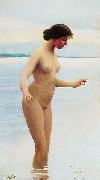 |
Eugen von Blaas -- Click Here
|
|
painted In the water in 1914 |
|
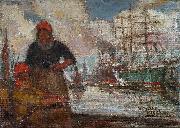 |
Eugeen Van Mieghem -- Click Here
|
|
(1 October 1875-1930) was a Belgian artist born in the port of Antwerp. As a boy Van Mieghem was confronted with the harsh reality of life at the waterfront.
Even at primary school he showed a talent for drawing. He was introduced to the work of Vincent van Gogh, Georges Seurat, Camille Pissarro, Henri de Toulouse-Lautrec and others at an exhibition organised by Flemish painter and architect Henry van de Velde at the Antwerp Academy around 1892. He attended the Antwerp Academy but was sent from school because his conservative teachers disliked his subject matter and his free, spontaneous way with it. He threw his lot in with progressive political and cultural movements, and joined an anarchist group. By the early 1900s was recognized as one of the most promising young artists of the Antwerp school. He would never renounce his idealism. He became the artist of the typical harbour folk: sack porters, sack makers, emigrants, dockers, bargees, and tramps.
Van Mieghem had his first taste of real success at La Libre Esthetique in Brussels, where his pastels and drawings hung alongside works by French impressionists such as Claude Monet, Paul Cezanne, Camille Pissarro, Jean Renoir and Edouard Vuillard.
|
|
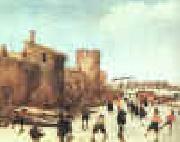 |
Esaias Van de Velde -- Click Here
|
|
1591-1630
Dutch
Esaias Van de Velde Gallery
Painter, draughtsman and etcher. He probably received his earliest training from his father. It is also possible that he studied with the Antwerp painter Gillis van Coninxloo, who moved to Amsterdam in 1595 (ten years after Esaias father). He may also have trained with David Vinckboons, whose work shows similarities with that of Esaias. Esaias became a member of the Haarlem Guild of St Luke in 1612, the same year as Willem Buytewech and the landscape painter Hercules Segers. During this Haarlem period Esaias had two pupils, Jan van Goyen and Pieter de Neijn (1597-1639), but by 1618 he had moved with his family to The Hague, where he joined the Guild of St Luke in October of that year. |
|
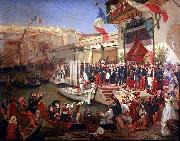 |
Ernest Francis Vacherot -- Click Here
|
|
painted Arrival of Marshal Randon in Algiers in 1857. |
|
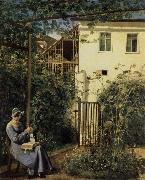 |
Erasmus Ritter von Engert -- Click Here
|
|
Austrian, 1796-1871 |
|
|
|
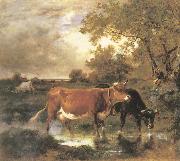 |
Emile Van Marcke de Lummen -- Click Here
|
|
1827-1890
Emile van Marcke was born in S??vres - into a family of artists. His father was Jean-Baptiste (1797-1848), the eldest son of Charles van Marcke and a painter who specialized not only in landscape and animal paintings, but also works on porcelain. |
|
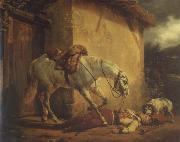 |
Emile Jean Horace Vernet -- Click Here
|
|
French, 1789-1863,Painter, son of Carle Vernet. He was born in his father's lodgings at the Palais du Louvre, where his grandfather Joseph Vernet also lived; his maternal grandfather was Jean-Michel Moreau. To these antecedents and influences are ascribed the supreme ease of his public career, his almost incredible facility and his fecundity. His early training in his father's studio was supplemented by formal academic training with Francois-Andre Vincent until 1810, when he competed unsuccessfully for the Prix de Rome. He first exhibited at the Salon in 1812. In 1814 Vernet received the Legion d'honneur for the part he played in the defence of Paris, which he commemorated in the Clichy Gate: The Defence of Paris, 30 March 1814. |
|
|
|
|
| | |
|
|
|
|